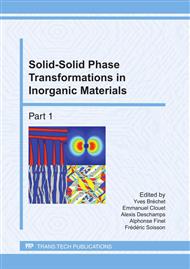p.863
p.869
p.875
p.881
p.887
p.893
p.899
p.905
p.911
Decarburization of 0.21C-1.3Mn-0.2Si Steel for Hot Stamping at Various Heating Temperatures
Abstract:
In order to examine the decarburization behavior in the hot stamping (HS) method, the dependence of the microstructure evolution on the annealing temperature was experimentally studied using a Fe-0.21 mass% C-1.3 mass% Mn-0.2 mass% Si steel. The steel was isothermally annealed in the temperature range of T = 773-1173 K for various times of t = 100-12800 s in an ambient atmosphere. Here, the steel possesses the ferrite (α) + cementite (θ) two-phase microstructure at T = 773-923 K, the α + austenite (γ) two-phase microstructure at T = 1013-1073 K, and the γ single-phase microstructure at T = 1093-1173 K. During annealing at T = 1013-1073 K for t = 1600 s, however, the α layer with a uniform thickness is formed at the surface of the steel due to decarburization and gradually grows into the inside. Such formation of the a layer was not clearly observed at T 973 K and T 1093 K. Thus, the formation of the α layer hardly occurs under the HS annealing conditions. At T = 1033 K, the thickness of the α layer is mostly proportional to the square root of the annealing time. Such a relationship is called the parabolic relationship. Furthermore, the grain size of the α layer monotonically increases with increasing annealing time. Hence, the parabolic relationship guarantees that the growth of the α layer is controlled by volume diffusion.
Info:
Periodical:
Pages:
887-892
Citation:
Online since:
June 2011
Keywords:
Price:
Сopyright:
© 2011 Trans Tech Publications Ltd. All Rights Reserved
Share:
Citation:


